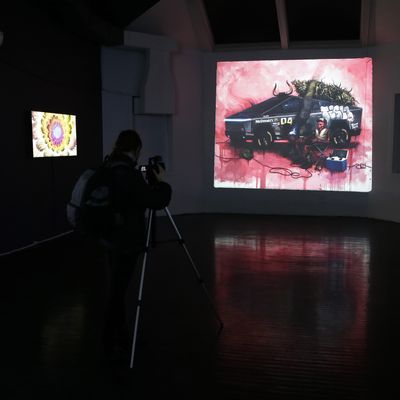
On my way to Superchief, which bills itself as the world’s “first physical NFT gallery,” I Googled “explain NFTs to me like I’m an absolute idiot.” Here is what I knew already:
• NFT stands for “non-fungible token,” meaning a unique asset, the authenticity of which is encrypted through blockchain technology, asserting its originality and, therefore, its worth.
• Collectors had started buying and selling NFT artworks like Beanie Babies in 1998, both through traditional auction houses like Christie’s or newer NFT marketplaces, and they were going for thousands and even millions in ether and bitcoin.
• Over the past month or so, they had become something of a meme, and that this was ironic or meta or something, because memes seemed to make up a lot of the visual language and subject matter of the NFTs themselves.
Here is what I didn’t know:
• Why should I care?
I appreciate art. I follow art. But I’m nowhere close to being a buyer or a collector of it. And most of what made NFTs significant and distinct, based on what I had read, was the way in which ownership is transferred and tracked. But people with money have always found ways to move it around: They buy houses, or horses, or paintings of houses and horses. To an outsider, NFTs reek of GameStop stonks and Elon Musk: more old-school capitalism, billed as something shiny and different because it’s online. A successful NFT exhibition would have to convince the visitor that these works represent something beyond the novelty of crypto.
The phrase “physical NFT gallery” seems oxymoronic. NFTs are digital art pieces inextricably linked to the blockchain. The whole reason why anyone cares about them in the first place seems to be that they’ve developed a way to assign scarcity and value to untouchable, intangible online art. With NFTs you can buy the rights to an image, but the artist still retains the canvas it was painted on before it was scanned, or the original raw data of the file, or the computer on which it was made. What would it mean to go to a gallery show where the original works are on display, but not really there?
There was a polite line forming outside of Superchief by the time I got there, a little before the gallery, just south of Union Square, opened its doors for the first time. The crowd was mostly who I’d imagine would be at any gallery show in the area: Dimes Square cool kids and young Parsons students in variously colored neon beanies, excited to take something in, in-person. This was the New York that was promised to them, only just now emerging after a year of shutdown. There were the expected tech bros, too, guys in their 30s walking down the street maskless until the last possible second before they joined the line. Across the street, people watched the crowd grow outside the gallery from a second story WeWork — a.k.a. the exact sort of business I’d imagine would be interested in purchasing and displaying NFTs.
The NFT exhibition is called “Season 1 Starter Pack,” its fluency in meme culture already baked into the title. Its premise is ambitious: 300 artists’ works, rotating through the display space daily, available for auction. At the very least, Superchief aimed to foreground what it would practically look like to display NFTs IRL. The gallery partnered with Blackdove, a company that manufactures high-resolution screens with the explicit purpose of displaying digital art. Like one of those digital picture frames that people buy for Mother’s Day but then never get around to setting up, only larger. Most of the works accommodated on these screens had what I perceived to be phone-friendly dimensions, oriented in both portrait and landscape, calling to mind the experience of scrolling through a Tumblr dashboard. In the darkened gallery (better for the screens to pop), I overheard someone say, “this is the first time I’m not worried about backing into the art, there’s nothing to bump into.” Sure, someone could accidentally crack a screen, but he had a point: It wouldn’t affect the original NFT.
It reminded me of the time I asked my parents to take a picture of me “touching the butt” of Matisse’s La Danse at MoMA. Posing with my hands hovering in front of the rarefied tush, I stumbled on my feet and the tip of the pad of my finger made contact within a millimeter of the surface of the canvas, and shockwaves of shame and adrenaline surged through my body at doing something so taboo and illicit as very nearly touching the art. It was chaos magic. It’s an anecdote I used to teach Walter Benjamin’s “The Work of Art in the Age of Mechanical Reproduction” as a teaching assistant, to explain the aura of the original work. NFTs are an attempt to imbue highly reproducible digital art with Benjaminian aura, but their encrypted digital butts are untouchable.
One of the crisp 4K screens displayed a work reminiscent of the manga series Ghost in the Shell: a CGI model of a hyper-futuristic woman dressed in gold hooked up to some sort of robotic exoskeleton, spinning in a blank white and space-less showroom. I watched as two visitors tried to read some text etched into the base of the model as it spun, but it moved too fast for them to make out. This work, like many of the others, would occasionally freeze in its loop, a loading wheel appearing while it recalibrated. This obvious materiality — of the computer-behind-the-screen lagging, freezing, and getting going again — actually gave the works a there-ness that I appreciated; a little bit of cyber grit. The artist’s and work’s names weren’t on display on any of the works in the space, and by the time I went to look this one up the next day, I couldn’t find it on the SuperChief NFT landing page. There was no record of it in the crypto-ledgers of listings, bids, and transactions, so either it hadn’t been put up for auction yet or I’m crypto-illiterate (possibly both).
Projected onto opposite walls in the gallery space was a large MP4 NFT by the tattoo artist MASHKOW, depicting a Tesla cybertruck with a Confederate flag on the dash and bullhorns on the roof and a McDonald’s bumper sticker on the front, an oversize nug tied to the back like a Christmas tree, with a redneck skeleton sitting in front. The MP4 rotates, revealing that the art is “painted” on a digital “canvas,” with stickers and graffiti tags on the back, including one that says “NFTesla.” The airbrushed aesthetic calls to mind something you’d see on the side of a van. But the stoner humor and sophomore symbolism (McDonald’s arches in pop art? Groundbreaking.) made this white artist’s use of a Confederate flag feel more like a cheap stunt than a work with anything to say.
One patron was particularly excited about the first work on display when you enter the space, one that isn’t digital at all: a stop-motion animation by the artist Swoon that shows an elaborate mask unfurling endless layers, sprouting strange appendages. The work seems ultra-tactile in contrast to the others, made of what looks like layers of painted paper. The visitor said they were a fan and a follower of Swoon, and gallery director Ed Zipco later informed me via email that the piece — Swoon’s first NFT work — sold for $11,000, and the gallery received three further commissions from her at the same rate.
NFTs clicked for me after speaking to Zipco, who pointed out that the artworks have built-in tracking ledgers that redefine the ways that online artists can actually benefit from the value their works accrue in the art world, ensuring them royalties on sales. His view of what Superchief and NFT could do for digital artists was one of democratization and access: He said the split between established artists and brands (Princess Nokia and Hood by Air are slated to display NFTs in the coming weeks) and outsider artists in the exhibition was something like 70/30; on unlabeled, hi-def screens, they’re presented on an equal playing field.
I couldn’t deny the anti-establishment hopefulness of Superchief’s “Season 1 Starter Pack.” But as a casual observer, it was just nice to go to an in-person exhibition again. Staring at screens is so much more fun in public.
More on NFTs
- Eminem and Snoop Dogg, Bored Ape NFT Evangelists, Drop a Song
- The Latest Masked Singer Reveal Is … NFTs?
- Dispatches From the NFT Art Boom



